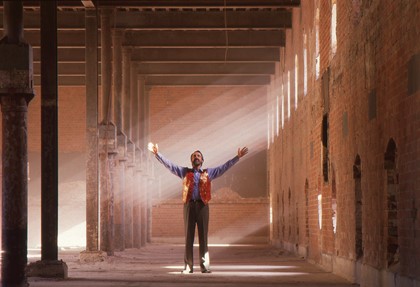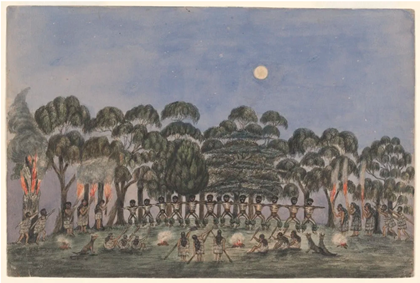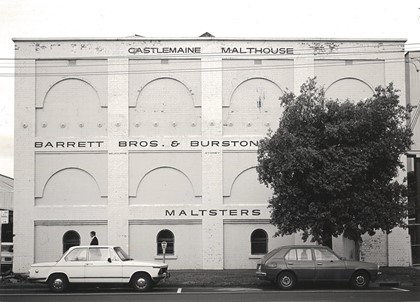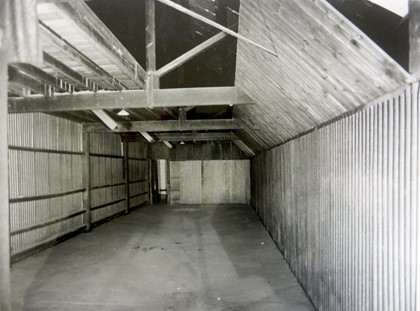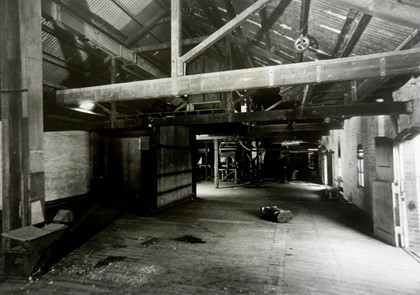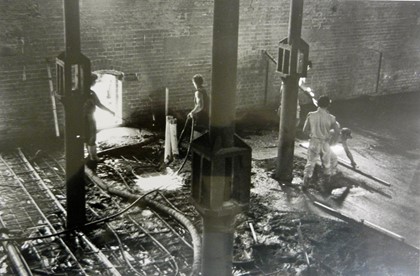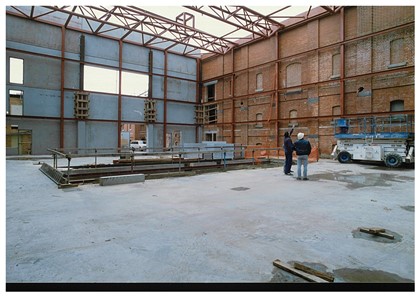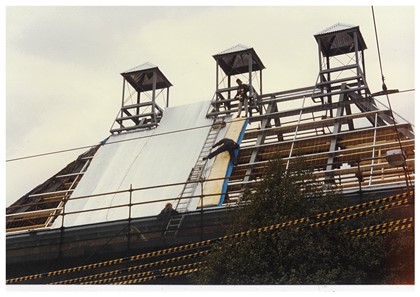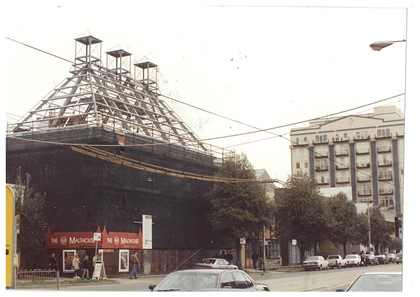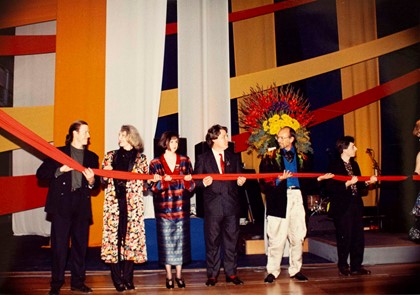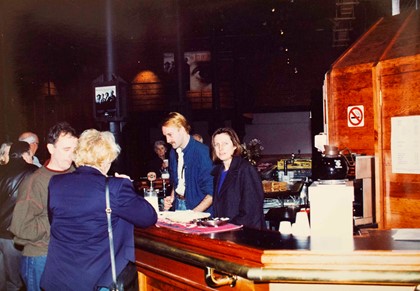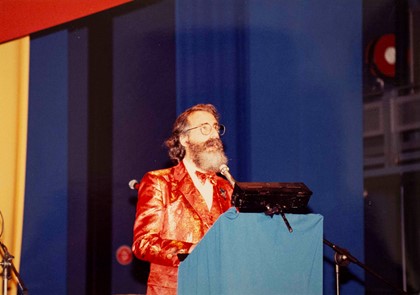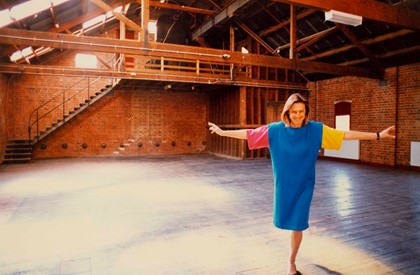The Malthouse building stands on the lands of the Wurundjeri and Boon Wurrung people, in what has become Melbourne’s iconic Arts Precinct. Built in 1882 amid a boom time for the city’s beer industry, its iconic architecture contains fascinating relics of its history, says historian Dr. Rob Reid.
The area now known as Southbank sits at the intersection of Boon Wurrung and Wurundjeri country. It was primarily fields and swamp lands, with the volcanic rock of Emerald Hill providing 'higher and drier locations for Willam or camp, places for ceremonies, tool manufacture, ochre collection and lookouts' according to local historian Meyer Eidelsonᶦ .
The ceremonies performed by the Yalukit Willam (people of the river) included the practice of Ngargee. Eidelson writes 'Ngargee were occasions to honour guests, showcase creativity in song and dance, ensure conciliation after conflict and to tell popular and new stories.'ᶦᶦ A famous Ngargee took place in Emerald Hill in 1840, as a means of reconciliation following a major formal judicial conflict between two tribes. Richard Howitt describes it in his book Impressions of Australia Felix (1846): 'Imagine fifty men of all ages dancing in mazes, first in one figure, then in another; one old man, apart from the rest, as master of ceremonies, indicating their movements by his own, and time beaten by a group of women seated round a huge fire.'ᶦᶦᶦ
During the 1850s the area around South Melbourne had become the houseless encampments known as Canvas Town. The Victorian Gold Rush caused an explosion in Melbourne’s population, and the resulting housing crisis saw immigrants forced to live in tents along the south bank of the Yarra river near Princes Bridge.
In 1857 an Irish solicitor, Edward Fitzgerald, established the Castlemaine brewery. Fitzgerald was joined by his brother, Nicholas in 1859, both sons of an Irish brewer. In 1871 they partnered with J B Perrins to build the brothers second building: an industrial Malting House in South Melbourne.
Commercial brewing had expanded significantly in the Australian colonies since 1802, when beer began to be promoted as a healthier alternative to rum. The Temperance movement arrived in Australia in the 1830s and members campaigned for anti-alcohol legislation such as six o’clock closing and dry suburbs. By the 1880s the Temperance movement was a major factor in the establishment of ‘coffee palaces’, venues that provided food and accommodation like the Public Houses but without alcohol. Despite their efforts, by 1871 there were 126 breweries in Victoria alone, and by the 1890s economic depression (and surreptitious drinking by patrons) largely closed Melbourne’s coffee palaces down.
The Malthouse was originally designed by Richard Buckley Whitaker, who also designed its sister building, the Castlemaine Brewery on Queensbridge Street. Built in 1892, the Malthouse is a late Victorian structure that was constructed of solid red brick, cast iron columns and an exterior finished in brick work with distinctive arched sections. Much of the building’s original architecture remains in place or has left traces of its original uses.
The café/restaurant area known as The Kiln was one of two kilns that sat at either end of the building, generating the heat to dry out the malt after soaking and germination. Three specially designed furnaces in each kiln would pump hot dry air out into the drying floor, where the malt grain would be spread out for drying. Today the only remnants of the drying floor are the cast-iron columns and lantern-shaped protuberances where the drying floor originally was, visible in the theatre’s vast foyer.
Similarly, the rehearsal room known as the Bagging Room still retains features of its originally function. The large barn doors along the Northern wall allowed the packaged malt to be loaded onto carts and transported to the company’s brewery on Queensbridge street. As you walk up the main stairs and through the company’s offices, you can see several large parts of the machinery involved in the malting process including timber hoppers, milling machinery and chutes.
By 1903 six brewers in Melbourne, including the Castlemaine Brewery had formed a cartel known as the Society of Melbourne Brewers to prevent competition from other brewers and to raise the price of beer, at a time when the growing temperance movement was agitating to raise taxes on beer and close hotels. In 1907 the society became Carlton United Breweries (CUB) and purchased the holdings of the six member companies, including The Malthouse. The Fitzgerald’s Castlemaine company had been motivated to be part of the merger due to bacterial contamination of their beer which contributed to a loss of profit. CUB continued to buy out other brewers, including the Abbotsford Co-operative Brewery in 1924, which had been specifically established to fight the anti-competitive practices of the Society of Melbourne Brewers.
In 1919 the Malthouse escaped a massive fire just next door when the Bust and Bills Brothers bedding and wire mattress factory was burned to the ground.
Between its acquisition in 1907 to the gifting of the building to the (then) Playbox Theatre Company in 1986, CUB tended to lease the Malthouse to smaller, independent brewers, including the Barrett Bros & Burston & Co., who had a long tenure in the building. By the mid 1980s it was sitting unused and in need of renovation.
In 1982, John Elliott, a rising star in the Australian corporate sector had acquired the jam maker Henry Jones IXL which he used to arrange a merger with Elders. Elders IXL then launched a successful takeover bid for Carlton and United Breweries, placing the holdings of the CUB into the hands of Elders IXL including the including the Malthouse, in 1983.
In February of 1984, Playbox Theatre Company has lost their theatre in a massive fire. The Playbox team, led by founding member Carrillo Gantner and relatively new company manager Jill Smith, commenced the search for a new home.
In 1986 Elliott and Elders IXL gift the old South Melbourne Malthouse to the still venueless Playbox to convert into a theatre. At the time the building was valued at two million dollars. The Victorian government contributed funds towards its renovation, Elders also contributed a further $80,000, but there was still a four-million-dollar short fall which the company raised from appeals to donors, subscribers and the community.
The design and construction of the two theatres was carried out by architect, set and lighting designer John Beckett. Beckett had a long history with the company, having been lighting designer for their very first production, Chidley, in the Grant Street Theatre, in 1976 and would continue designing for the company well into the 1990s.
Playwright Barry Dickins recalled seeing Beckett and the Malthouse site:
'There is nothing. There are old bricks. A few puddles. Bits of crooked pipe. In the early morning light in Sturt Street there is only John Beckett. He is looking at a stone-cold cup of cocoa and thinking of—who knows what he is thinking of! He is thinking of theatres and seeing them where there is nothing.'ᶦᵛ
John Ridge describes the transformation process the building was to undergo.
'The task was formidable. The greater part of the building was covered in an ugly cream kalsomine paint, extremely difficult to remove. In fact, it took three solid months of steam-cleaning to restore the pristine appearance of the brick, while the entire interior underwent a process of dust-blasting to get rid of the whitewash, kalsomine, and remnants of tar-paper lining…'ᵛ
The two theatres were initially designed to be flexible and able to be rearranged to present completely changed play spaces. This included the installation of custom designed moveable and removable audience seating in the Merlyn that were moved on cushions of compressed air. Against the tradition of the black box, the Merlyn theatre was originally painted a sky blue colour intended to make it a neutral space. It was repainted black after Michael Kantor and Stephen Armstrong took over the leadership of the company in 2003.
The renovation of the building was inevitably delayed by industrial action and weather conditions. Construction issues likewise plagued the building and its administration for decades to follow. The Malthouse began operation as the base for Playbox in 1988 and launched officially in 1990. The larger theatre was named The Merlyn, after Dame Merlyn Myer to honour her philanthropy and support of the arts in her life and in recognition of the support of the Myer Foundation and Sydney Myer Fund in the renovation project, and the smaller The Beckett, in recognition of the work done by the theatre’s designer. The Beckett was only intended to be the theatre’s temporary name, as Gantner said in 1990, 'I have told him that the name is only his until someone offers us a big enough donation to warrant having a theatre named after them.' The name remains unchanged.
The newly launched Malthouse Theatre was decorated with original artworks commissioned by the company for a series called the Phantom Figures. Production Manager Robert Taylor recalls:
'Part of the design concept for the new CUB Malthouse Theatre Complex in 1990 was to commission a series of large wall panels from Australian artists, designers, theatre workers, photographers and creatives. These were hung mainly in The Merlyn Theatre. From memory there were about 27 completed. Those involved included Mirka Mora, Barry Dickens, Anne Fraser, Phillip Faulks, Sandra Matlock, Lin Onus, Irene Barberis, and Peter Corrigan.'ᵛᶦ
At the time, Gantner described the artworks as representing ‘the audience behind the audience.’ The paintings were eventually removed and placed in storage during the company’s rebranding from Playbox to Malthouse.
The premier season in the new theatres consisted of eight Australian plays. The Beckett was opened with The Forty Lounge Café by Tess Lyssiotis and directed by Rob Draffin on 16 March and the Merlyn was opened with Café Fledermaus by Robyn Archer and directed by Barrie Kosky on 25 May. The official launch and celebration of the new theatre complex was a gala affair, hosted on 25 August. It was attended by company and board members, donors, sponsors and the arts community, among them the Arts Minister Jim Kennan, artist Mirka Mora and playwrights Joanna Murray Smith and Ron Elisha. The launch also featured commemorative poster artwork by the European graphic artists Brosi Bucan, depicting a phoenix rising from the ashes. A signature orchestral fanfare composed by Stuart Greenbaum, written for handbells, brass and percussion. Speaking at the launch, Gantner told the crowd that 'Playbox had finally come home.'ᵛᶦᶦ
Upgrades to the building during this time include the installation of an elevator, carpeting, air conditioning upgrades, leaky roofing, and constantly shifting placement and management of a café/restaurant somewhere in the foyer.
The 1990s saw an increase in investment from business and local government focused on developing the largely disused and industrial areas of south Melbourne, which will gradually culminate in the Southbank cultural precinct. This included redevelopment of the river side areas and casino, the construction of a new tunnel under the city to accommodate for increased traffic from the western suburbs, and a new cultural precinct based around the Victorian College of the Arts, the ACCA, a new home for dance company Chunky Move and The Malthouse.
While at the same time contending with contaminated soil, massive budget overruns, structural disruption from the building works related to the Burnley and Domain Tunnels being constructed directly under the theatre and included a protracted debate over the presence of a possible underground car park, the management of the Malthouse took the leadership of the cultural precinct project.
The new plaza between the Malthouse, ACCA and Chunky Move was launched in August 1999 by then Minster for the Arts, Mary Delahunty, and was named ‘Ngargee’. Senior Boon Wurrung Elder N’arweet Carolyn Briggs AM recalls:
'…We named this place Ngargee, to reflect the coming together of the visual arts, performance, story and dance. The idea of Ngargee, in this place, in this built environment…is focused upon bringing people together for cultural practice, ceremony and performance. It gives us a sense of purpose, and a place that we can create and find our own narratives.'ᵛᶦᶦᶦ
The Malthouse building was a lifeline for Playbox at the time of its donation, and a vital home for new Australian playwriting. It’s one of the oldest still functional buildings in Southbank and, while its architecture represents an unbroken link with the industrial era and founding days of Melbourne, its stage continues to showcase some of the most innovative theatre in the country.
Dr . Robert Reid is an independent playwright, theatre historian, immersive performance designer and critic. They were the artistic director of independent theatre company Theatre in Decay and immersive performance and game company, Pop Up Playground. Dr . Rob's plays have been performed by the MTC and Black Swan, and their immersive works have been presented by the MSO, SLV, City of Melbourne, Bell Shakespeare and the Melbourne Football Club. Dr. Rob has a PhD in Australian Theatre History, was a co-founder and co-editor of WitnessPerformance.com and now runs the YouTube channel, Television is Furniture presenting reviews, history and analysis of contemporary Australian theatre.
Citations & References
ᶦ Eidelson, Meyer. Yalukit Willam: The River People of Port Phillip, St. Kilda, Victoria: City of Port Phillip Art & Heritage Unit, 2015. p10
ᶦᶦ Ibid. p29
ᶦᶦᶦ Howitt, Richard, "Impressions of Australia Felix". Settler Literature Archive. 1845, p75.
[URL: https://commons.und.edu/settler-literature/75]
ᶦᵛ Copland, Murray. and Playbox Theatre (Melbourne, Vic.). Playbox at the CUB Malthouse : a pictorial history / edited by Murray Copland ; designed by Malpass and Burrows ; chief photographer David B. SimmondsPlaybox Theatre Centre of Monash University South Melbourne, 1990
ᵛ Ibid.
ᵛᶦ Personal correspondence between R. Taylor and R Reid, 2022, email, held in the author's collection
ᵛᶦᶦ "ARTS & ENTERTAINMENT Playbox Theatre comes home" The Australian Jewish News (Melbourne, Vic. : 1935 - 1999)20 July 1990: 43. Web. 25 Jun 2022 [URL: http://nla.gov.au/nla.news-article261654427 ].
ᵛᶦᶦᶦ N’arweet Carolyn Briggs AM and Sarah Lynn Rees in conversation with Max Delany. Ngargee Djeembana: On the materiality of public space and Country. Artlink, 29 November 2021
[URL: https://www.artlink.com.au/articles/4916/ngargee-djeembana-on-the-materiality-of-public-spa/ ]
